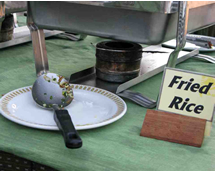Bacillus cereus blood stream infections in newborns, that has sadly claimed the life of one of these babies. So far 18 cases have been identified in a number of different hospitals. It is thought that the cause is contamination of parenteral nutrition given intravenously to premature babies when they are unable to feed for themselves.

poisoning (e.g. fried rice) but as most laboratories do not routinely look for B. cereus in stool samples (it is technically very difficult to separate it out from other gut flora) it is not routinely reported. B. cereus grows in food held at room temperature allowing toxins to be produced or the bacteria to multiply.
1. Heat stable toxin (present in the food before it is eaten) causes vomiting within 30 minutes to 6 hours of ingestion
2. Heat labile toxin (spores develop into bacteria in the gut and produced the toxin) causes diarrhoea within 6 to 24 hours of ingestion
Public health may investigate an outbreak of food poisoning by asking for stool samples from patients to be sent to a reference laboratory for either B. cereus culture or toxin
detection in order to identify the cause.
There is no specific treatment of B. cereus food poisoning; supportive care is required to maintain fluid balance.
Prevention of B. cereus is the only real option. This is achieved by refrigerating food and not leaving it at room
temperature (which prevents bacteria multiplying and producing heat stable toxin), then reheating it quickly and thoroughly before eating (to kill off any residual spores and bacteria).
Contamination is the most common context in which I have seen Bacillus spp. (including B. cereus) grown in blood
cultures. In this situation the spores of the bacteria have colonised the top of the blood culture bottle (usually because it has been stored for a long period of time and has become dusty!) When the blood culture bottle is filled with a patient’s blood the needle entering the bottle carries the spores in to the culture liquid and the spores vegetate and the bacteria grow. The bacteria weren’t in the blood originally and so this is known as a contaminant or
pseudobacteraemia. The patient does not have an infection with a Bacillus spp.
Very occasionally Bacillus spp. are seen as causes of blood stream infections. In this case the source is usually a central venous catheter (CVC) which has been in a patient for some time. The spores of the bacteria enter the CVC where they begin to grow and cause an intravenous (IV) device infection. Without the IV device the infection cannot occur. The treatment is therefore to remove the infected device. Rarely Bacillus spp. can cause infections of other IV devices such as prosthetic heart valves, stents and coils used to block blood vessels. All are treated on an individual basis based upon laboratory tests of antibiotic sensitivities.
B. cereus blood stream infections are rare but serious
(I have seen 2 in 12 years of microbiology) however contamination of blood cultures with Bacillus spp. is more common. Microbiologists are monitoring this current outbreak and the manufacturer has recalled the batch of feed. As this infection is rare and Bacillus spp. are usually
considered contaminants it is of great credit to those involved in these recent cases that they spotted that an outbreak was occurring. Their decisive management has certainly prevented further harm to any more babies.
 RSS Feed
RSS Feed
